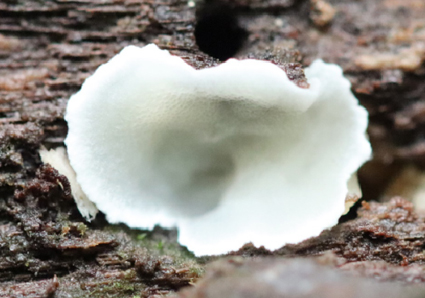Abstract
Flaviporus is a small genus within the wood-inhabiting family Steccherinaceae. Macroscopically, it is characterized by watery and resinous basidiomes that become hard and tend to shrink when dried, and microscopically by agglutinated hyphae that are difficult to observe. The present study proposes Flaviporus albus sp. nov. as a new species based on morphological and phylogenetic evidence. It is characterized by a white to cream pileus surface, small pores (10–14 per mm) with irregular dissepiments, and the presence of rather thin-walled to thick-walled skeletocystidia. The basidiospores are broadly ellipsoid to subglobose, measuring 2.1–2.6×1.7–2.3 μm, commonly with an oil drop, hyaline and have a thickened wall. These basidiospores do not show any reaction to Melzer’s or Cotton Blue. Furthermore, this study presents a key to the globally known species of Flaviporus.
References
- Alick, H. (2010) Fungal Portraits: No. 43: Flaviporus brownii. Field Mycology 11 (3): 75–77. https://doi.org/10.1016/j.fldmyc.2010.07.003
- Berkeley, M.J. & Curtis, M.A. (1868) Fungi Cubenses (Hymenomycetes). Journal of the Linnean Society, Botany 10: 280–392. https://doi.org/10.1111/j.1095-8339.1868.tb00529.x
- Corda, A.K.J. (1842) Anleitung zum studium der mycologie. s.n.
- Dai, Y.C. (2004) Notes on the genus Antrodiella (Basidiomycota, Aphyllophorales) in China. Mycotaxon 89: 389–398.
- David, A. & Rajchenberg, M. (1992) West African polypores: new species and combinations. Mycotaxon 45: 131–148.
- Donk, M.A. (1960) The generic names proposed for Polyporaceae. Persoonia 1 (2): 173–302.
- Ginns, J. (1980) The genus Flaviporus Murrill (Polyporaceae). Canadian Journal of Botany 58 (14): 1578–1590.
- Ginns, J. (1984) New names, new combinations and new synonymy in the Corticiaceae, Hymenochaetaceae and Polyporaceae. Mycotaxon 21: 325–333.
- Gray, S.F. (1821) A natural arrangement of British plants, vol. 1. London, Baldwin, Cradock, and Joy, pp. 1–824.
- Huelsenbeck, J.P., Ronquist, F., Nielsen R. & Bollback P.J. (2001) Bayesian inference of phylogeny and its impact on evolutionary biology. Science 294 (5550): 2310–2314. [http://www.jstor.org/stable/3085235]
- Kreisel, H. & Schauer, F. (1987) Methoden des mykologischen Laboratoriums. VEB Gustav Fischer Verlag, Jena, 181 pp.
- Larget, B. & Simon, D.L. (1999) Markov chain Monte Carlo algorithms for the Bayesian analysis of phylogenetic trees. Molecular biology and evolution 16 (6): 750–759. https://doi.org/10.1093/oxfordjournals.molbev.a026160
- Li, Q.S. & Wei, Y.L. (2021) Species composition and distribution characteristics of wood-decaying fungi in tropical areas of China. Mycosystema 40 (10): 2653–2672. https://doi.org/10.13346/j.mycosystema.210212
- Miettinen, O., Larsson, E., Sjökvist, E. & Larsson, K.H. (2012) Comprehensive taxon sampling reveals unaccounted diversity and morphological plasticity in a group of dimitic polypores (Basidiomycota, Polyporales). Cladistics 28: 251–270. https://doi.org/10.1111/j.1096-0031.2011.00380.x
- Miettinen, O. & Ryvarden, L. (2016) Polypore genera Antella, Austeria, Butyrea, Citripora, Metuloidea and Trulla (Steccherinaceae, Polyporales). Annales Botanici Fennici 53: 157–172.
- Murrill, W.A. (1905) The Polyporaceae of North America: XI. A synopsis of the brown pileate species. Bulletin of the Torrey Botanical Club 32 (7): 353–371. https://doi.org/10.2307/2478499
- Murrill, W.A. (1905) The Polyporaceae of North America-XII. A synopsis of the white. Bulletin of the Torrey Botanical Club 32 (9): 469–493. [https://www.jstor.org/stable/2478463]
- Niemelä, T. & Ryvarden, L. (1983) Antrodiella citrinella, a new polypore species. Karstenia 23: 26–30.
- Nylander, J. (2004) MrModeltest V2. program distributed by the author. Bioinformatics 24: 581–583.
- Rabenhorst, G.L. (1876) Polyporus braunii Rabenh., Fungi europaei exsiccate Cent. 4: no. 2005.
- Rajchenberg, M. & Wright, J.E. (1987) Type studies of Corticiaceae and Polyporaceae (Aphyllophoralles) described by C. Spegazzini. Mycologia 79 (2): 246–264.
- Rambaut, A. (2012) FigTree version 1.4.3. [http://tree.bio.ed.ac.uk/software/soft-ware/figtree/]
- Ridgeway, R. (1912) Color Standards and Color Nomenclature. pp. 12–225.
- Ryvarden, L. & Johansen, I. (1980) A preliminary polypore flora of East Africa. s.n., pp. 1–636.
- Schweinitz, L.D. von (1822) Synopsis fungorum Carolinae superioris. Schriften der Naturforschenden Gesellschaft zu Leipzig 1: 20–131. [https://archive.org/details/bub_gb_qVMVAAAAYAAJ/page/n31/mode/1up]
- Stӧver, B.C., Müller, K.F. (2010) TreeGraph 2: combining and visualizing evidence from different phylogenetic analyses. BMC Bioinformatics 11: 7.
- Swofford, D.L. (2002) PAUP*. Phylogenetic analysis using parsimony (*and Other Methods), Version 4.0 beta version. Sinauer Associates, Sunderland, Massachusetts.
- Vilgalys, R. & Hester, M. (1990) Rapid genetic identification and mapping of enzymatically amplified ribosomal DNA from several Cryptococcus species. Journal of Bacteriology 172 (8): 4238–4246. https://doi.org/10.1128/jb.172.8.4238-4246.1990
- Vu, D., Groenewald, M., Vries, M.de., Gehrmann, T., Stielow, B., Eberhardt, U., Al-Hatmi, A., Groenewald, J.Z., Cardinali, G., Houbraken, J., Boekhout, T., Crous, P.W., Robert, V. & Verkley, G.J.M. (2019) Large-scale generation and analysis of filamentous fungal DNA barcodes boosts coverage for kingdom fungi and reveals thresholds for fungal species and higher taxon delimitation. Study In Mycology 92: 135–154. https://doi.org/10.1016/j.simyco.2018.05.001
- Westphalen, M.C., Motato-Vásquez, V., Rajchenberg, M. Tomšovský, M., Gugliotta, A.M. & Silveira, R.M.B.D. (2022) New insight on Flaviporus (Polyporales) in the neotropics. Mycological Progress 21: 93. https://doi.org/10.1007/s11557-022-01845-6
- Westphalen, M.C., Rajchenberg, M., Tomšovský, M. & Gugliotta, A.M. (2018) A re-evaluation of Neotropical Junghuhnia s. lat. (Polyporales, Basidiomycota) based on morphological and multigene analyses. Persoonia 41: 130–141. https://doi.org/10.3767/persoonia.2018.41.07
- Westphalen, M.C. & Silveira, R.M.B.D (2012) Resupinate polypores from mixed ombrophilous forests in southern Brazil. Mycotaxon 122: 111–122. http://dx.doi.org/10.5248/122.111
- Westphalen, M.C., Tomšovský, M., Gugliotta, A.M. & Rajchenberg, M. (2019) An overview of Antrodiella and related genera of Polyporales from the Neotropics. Mycologia 111 (5): 813–831. https://doi.org/10.1080/00275514.2019.1633895
- White, T.J., Bruns, T., Lee, S. & Taylor, J.W. (1990) Amplification and direct sequencing of fungal ribosomal RNA genes for phylogenetics. In: Innis, M.A., Gelfand, D.H., Sninsky, J.J. & White, T.J. (Eds.) PCR Protocols: a Guide to Methods and Applications. Academic Press, New York, pp. 315–322. https://doi.org/10.1016/B978-0-12-372180-8.50042-1
- Wu, F., Yuan, H.S., Zhou, L.W., Yuan, Y., Cui, B.K. & Dai, Y.C. (2020) Polypore diversity in South China. Mycosystema 39 (4): 653–682. https://doi.org/10.13346/j.mycosystema.200087
- Xing, J.H., Sun, Y.F., Han, Y.L., Cui, B.K. & Dai, Y.C. (2018) Morphological and molecular identification of two new Ganoderma species on Casuarina equisetifolia from China. MycoKeys 34: 93–108. https://doi.org/10.3897/mycokeys.34.22593
- Zheng, H.F., Huang, F.C., Liu, B. Shao, Y.Y. & Qing, P.S. (2021) Fulvifomes nonggangensis and F. tubogeneratus (Hymenochaetales, Basidiomycota): Two New Species from Southern China Based on Morphological and Molecular Evidences. Mycobiology 49 (3): 213–222. https://doi.org/10.1080/12298093.2021.1932162


